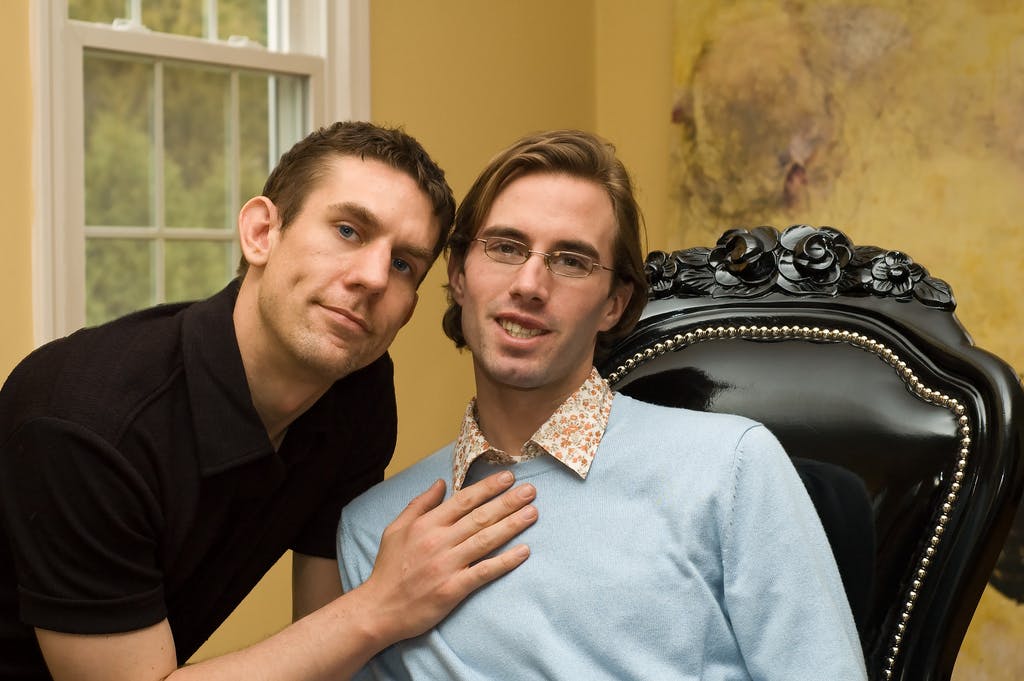From television dramas like Castle to comedies like The Mindy Project, sex scenes are ubiquitous; two heterosexual characters fall upon each other in a frenzy of unstoppable attraction, tearing their clothes off, tumbling into bed, and filling the screen with a series of escalating moans. (On more family-friendly networks, the music swells and the scene politely fades to black.)
What you won’t see on television, however, is queer sex, with a vanishingly few number of exceptions.
One such: The undeniably hot scenes cropping up on the latest Shonda Rhimes-produced hit, How to Get Away with Murder. Key character Connor (Jack Falahee) hasn’t just been having The Gay Sex; he’s been having it all over the screen to collect evidence (meanwhile, the pilot included quite the racy cunnilingus scene, illustrating that the show is an equal opportunity sex-fest).
Likewise, on Rhimes’ Grey’s Anatomy, Arizona (Jessica Capshaw) and Callie (Sara Ramirez) frequently have explicit sex—there is no discreet fade to black, or oblique reference to lesbian sexuality—and, in fact, their sex life after Callie’s amputation proved to be an important storyline. Meanwhile, on Scandal, Cyrus Beene (Jeff Perry) has been involved in a number of relationships, all of which have specifically included sex on screen. The common thread here is one woman, who seems to be dominating Hollywood more by the second.
Rhimes doesn’t just have a passion for making people have sex in her shows, but specifically a passion for making sure that everyone has sex in her shows. And not everyone is a fan, as evidenced by a recent tweet complaining about the sex on How to Get Away with Murder:
. @Dabdelhakiem There are no GAY scenes. There are scenes with people in them.
— shonda rhimes (@shondarhimes) October 19, 2014
Her series of responses were a sharp rebuke to the idea that “gay sex” should be handled differently on television (notably, the network didn’t complain about the scenes or storylines at all), and instead categorized queer sexuality as what it is: people who happen to be having sex. Further, she added, “If you are suddenly discovering that Shondaland shows have scenes involving people who are gay, you are LATE TO THE PARTY.”
It’s telling that even a fairly staid network like ABC is perfectly capable of handling gay sexuality, but apparently its audiences are not. However, media reception has roundly supportive of the show’s “gay sex stampede.” Vanity Fair called How to Get Away with Murder “the most progressive show on television,” and the magazine’s Richard Lawson said, “It’s doing something pretty remarkable, something that feels big and important and noteworthy, in the coolest and most casual of ways.” Chris Harnick of E! further argued that it’s “changing television” by treating its gay character as “as anything but a token.” Harnick said, “The show is unapologetic about depicting his sex scenes—and why should they be? It’s 2014.”
At The Daily Beast, Kevin Fallon speaks to the fact that the gay characters on Rhimes’ shows are neither saints nor stereotypes, but flawed and real human beings, with a focus on who they are as people and characters, not on their gayness.
Cyrus is not perfect. In fact, he might even be evil. And like all of the characters on Scandal, his imperfect devilishness is colored by the actor’s sympathetic and humanizing performance. There doesn’t even seem to be any handwringing about whether to have Cyrus complicit in Scandal’s more uncouth machinations. The groundbreaking thing about Shondaland is that its gay characters are finally allowed to have all the uncouth fun all the straight characters have been having on TV for years.
Furthermore, he adds, Shonda was doing it first:
Grey’s Anatomy’s Callie (Sara Ramirez) and Arizona (Jessica Capshaw) are monumental because they were lesbian characters in what was, at the time, the most popular show on television (yes, Grey’s is still on and still popular, but it used to be a phenomenon); that was five years ago when things were actually quite different in terms of gay visibility in the media; and they actually got married on the show, before same-sex legalization was a national movement.
He also observed that the sex scenes between gay characters aren’t quiet, subdued, or stilted, but hot: exactly what heterosexual viewers have come to expect from the handling of their own sexuality. There’s a reason that shows like Murder are developing such a loyal and committed following, and it’s not necessarily the absurd storylines, soapy plots, and the like. Rhimes’ characters are wet and messy in more ways than one, and that provides quite an appeal for viewers who are tired of seeing queer sexuality referenced only obliquely, if at all, with gay characters more like roommates with romantic pretensions than people who actually have sex with each other (and like it).
Shonda Rhimes’ tendency to be ahead of the curve when it comes to the depiction of minorities is a marked reason why she’s such a popular and beloved producer and creator. Rhimes doesn’t just make TV. She makes television; she develops the kinds of shows and ideas that other producers, showrunners, and writers race to imitate. As a creator, she wields tremendous cultural and political influence and has become a tastemaker, something that puts her in a position few women in Hollywood, let alone black women, enjoy.
What’s important about the frank look at human sexuality on Shonda Rhimes’ shows isn’t just that she integrates gay characters seamlessly into her casts, but that she shifts them out of the commonly desexualized narratives assigned to queer people in television, as Fallon notes.
To be queer on television is typically to be desexualized, to avoid scaring the heterosexual horses. Gay characters may exchange chaste pecks on the cheek or hold hands, and shows may reference their relationships, but that’s about where they stop. Rarely do viewers see flirting or the draw of attraction, let alone the kind of making out and active sex that they might come to expect from heterosexual characters. If television is to be believed, gay people never have sex, and indeed rarely touch each other at all; though they may climb into bed together sometimes, that’s purely because of practicality, not because they’re sexually attracted to each other and would like to act on that attraction.
The inclusion of gay characters on television shows is frequently heralded as a progressive move—at last, a gay character! Yet, gay characters in recent years haven’t necessarily represented the full spectrum of the gay experience, and they certainly haven’t been, well, gay. Kurt Blaine (Chris Colfer), for example, was a flagship gay character, but he didn’t seem to spend very much time actually making out or having sex with boys—even in high school, gay teens are just as active as their heterosexual counterparts.
On a show that was refreshingly comfortable with showing disabled sexuality, it’s telling that Kurt wasn’t allowed the full scope of his own sexual identity. When he lost his virginity, it was barely a blip on the screen. As Queerty’s Brody Brown noted, “We’re supposed to accept that the boys have ditched their purity rings based on tasteful shots of interlocking hands and smiling faces.”
On shows like Modern Family, The Fosters, and Brooklyn Nine-Nine, we never actually see gay sex, though it is implied, with the shows cashing in on their progressive cred as representations of gay people. It takes grittier programming like House of Cards to show gay sexuality, and even then, it doesn’t compare to the heterosexual scenes, many of which are quite explicit. Gay people, it turns out, just don’t really like to have sex, apparently.
Turning to television to reflect images of themselves, heterosexuals have lots of examples, but queer viewers have vanishingly few. For them, television provides glimpses and hints of what happens behind closed doors, but the primary presentation of queerness is of a tight, contained package that includes a limited number of roles and stereotypes, all carefully calculated to cause the least offense. A no-holds-barred take on gay sexuality is, apparently, too much for most producers, but Rhimes doesn’t have that inhibition, any more than her gay characters do.
What’s bothering people about the sex scenes on How to Get Away with Murder isn’t so much that gay characters are present, or even the superficial knowledge that gay people have sex: It’s the front and center positioning of that sex as something that’s actually happening. The complaints echo the admonitions to not “act gay” in public, whatever that means, and the perils that await queer people in the real world if they openly express their sexuality, even in the most minor of ways.
If television viewers can’t handle gay people having sex on TV, perhaps it’s no wonder that they clutch their pearls at the sight of two men holding hands on the street, or two women kissing at a bus stop, when they wouldn’t think twice about a heterosexual couple doing the same thing.
Photo via David Goehring/Flickr (CC BY 2.0)

